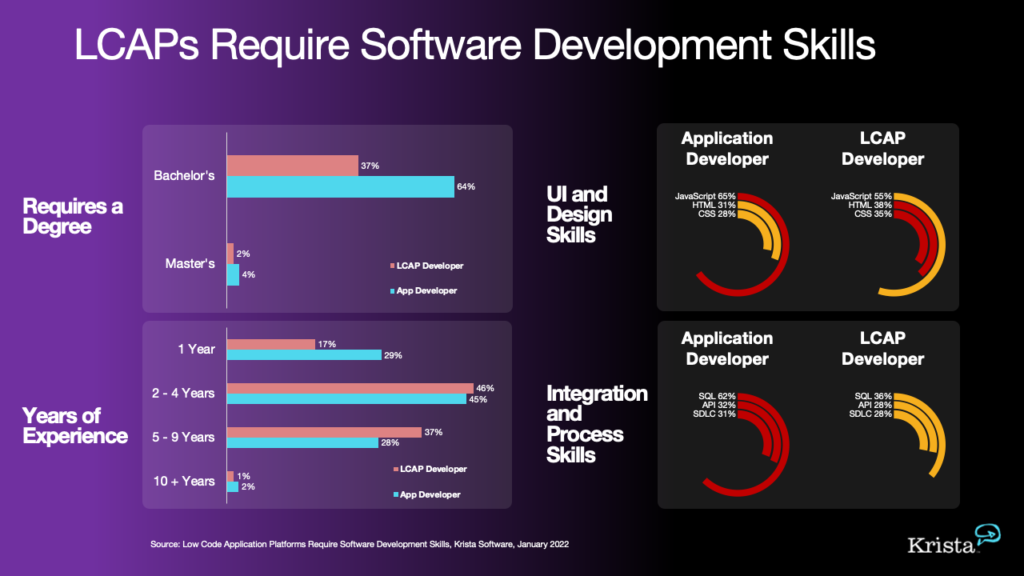Great Ideas On Deciding On Legacy application modernization with Low-code
Great Ideas On Deciding On Legacy application modernization with Low-code
Blog Article
Advantages Of Low Code Application Development For Developers Who Are Not Developers.
Low-code development of applications significantly increases accessibility for non-developers, often called "citizen developers" because of several important factors: Intuitive Visual Interfaces:
Drag-and-Drop Builders. Low-code platforms come with drag-and-drop interfaces. This allows non-developers the ability to create applications in a visual manner, without writing code. This makes development easier for people with backgrounds in technology.
WYSIWYG editors Editors that use WYSIWYG: These "What You See Is What You get" editors let users build interfaces and workflows that look similar to the final version. This makes it much easier to use and understand.
Simple Logic and Workflow
Visual Workflow modeling: Users create business processes and application logic with visual flowcharts. The models are simpler to use than conventional method of programming.
Pre-built Components of Logic: Low-code platforms often come with pre-built logic (e.g. loops, conditional statement) that are easily configured, reducing a need for complex programming.
Reusable Templates and Components:
Libraries of prebuilt templates: Low-code platforms typically offer libraries of templates for various types of application. This allows non-developers the opportunity to start with a solid basis and then modify it according to their needs.
Reusable widgets and modules The development of a website is simplified by using reusable components as well as modules. This reduces the requirement for technical expertise.
Guided Development and Tutorials
Step-by-Step Instructions: Platforms frequently provide guided development pathways or online tutorials screen-based instructions that can assist those who are not developers in developing applications.
Interactive Tutorials Interactive tutorials and hands-on ones enable users to learn by doing. They gain confidence by using the platform.
Integration with an existing tool:
seamless integration: Low-code platform are designed to integrate seamlessly with the existing business tools, systems, as well as software (e.g., ERP and CRM). This enables non-developers who do not have a background in programming to build applications that can work with their existing workflows.
APIs and Connectors : APIs built-in and connectors let users and non-developers to connect applications to external services without the need to write complex code.
Collaboration Features:
Team Collaboration: Features, such as real-time collaboration as well as shared workspaces, help professionals and non-developers to collaborate efficiently.
Role-based access control: Access levels are able to be set for those who are not developers to ensure they can still contribute to development without jeopardizing security.
Automated Testing and Debugging
Test tools are included: A lot of low-code platforms include built-in testing and debugging tools. These tools streamline the process, making it easier for non-developers to ensure their apps are functioning properly.
Error Highlighting: When problems occur, the platform highlights the errors and suggests solutions, guiding non-developers through troubleshooting steps.
The main benefit of developing applications using low-code in terms of accessibility for non-developers is in its ability to make the development process more accessible. Platforms that use low-code empower business users by offering them easy-to-use, visual and guidance tools. They are then able to actively take part in the process of developing and maintaining applications. Follow the top rated agree with on Low-code Platform for application development for website info including azure sql databases, rapid action development, driver jdbc, azure sql, ms azure sql, develop cross platform mobile app, database in azure, cross platform app dev, push alerts, rad application development and more.
Cost-Effectiveness Is Just One Of The Many Advantages Of Developing Applications With Low-Code.
Low-code application development has a number of benefits, including cost efficiency. This is a great option for businesses who want to optimize development budgets without sacrificing quality. The following are some key benefits.
Less Coding Requirements: The low codes platforms remove the need for extensive, hand-coded applications. Developers can save time and energy developing applications. This means less labor costs.
Fewer Developer Resources: Since low-code development is more efficient and simpler, less specialized developers are needed. The cost of hiring and staffing could be reduced significantly.
Speedier Time to Market
Rapid development process Visual development tools and pre-built components provided by low-code platforms allow rapid application development. This allows companies to get their products to market quicker. This can translate into faster revenue generation and improved positioning in the market.
Rapid Prototyping. By quickly creating and testing prototypes businesses can speed up developing and develop faster on feedback from users.
Reduced Maintenance Costs
The modular structure and standard components of apps developed using low-code platforms make them easier to maintain. This reduces the ongoing maintenance and support costs.
Automated Patches and Updates: Low-code platforms can manage updating and patching applications in a way that is automatic. This ensures that your application remains secure and always up-to-date without extensive manual intervention.
Efficient Resource Utilization:
Low-code platform contributions let both business users and other non-developers to participate in the process of creating. This makes it possible for businesses to take advantage of the talents of a diverse variety of employees.
Optimized use of IT resources IT departments get the opportunity to focus on more strategic projects instead of being sucked into simple work tasks for development. Overall productivity and efficiency are improved.
Scalable Pricing Models
Subscription-Based Price: Many low code platforms offer an affordable subscription-based pricing model that grows depending on use. This allows business to be able to align their spending with the actual demands and growth while avoiding significant up-front costs.
Pay-As-You-Go options Certain platforms allow companies to pay for only the amount they spend. This is especially beneficial for small or start-up businesses with a limited budget.
Reduce the cost of Third-Party software:
Low-code platforms are often equipped with integrated functions that eliminate the need to purchase extra software or tools. This can help you save cash on subscriptions and licensing costs.
Pre-Built Integrations: By integrating popular services and systems, you can save time and money by not having the need to develop custom integrations.
Improved ROI:
A faster return on investment: Rapid development and lower costs, coupled with an increased time to market allows businesses to get a greater return on investment.
Enhanced Ability. Businesses can adapt quickly to the ever-changing market conditions and customer requirements. This will help them remain relevant, and they can take advantage of any new opportunities.
Training costs are less:
User-Friendly Interfaces: The nimble user-friendly interfaces on low-code platforms cut down on the learning curve of new users, eliminating the need for extensive training programs.
Accessible Resources that are accessible. Many low-code platforms provide comprehensive training material and tutorials as well as community assistance. They make it less necessary to attend formal training which can be expensive.
Collaboration is made easier:
Collaboration Tools: Integrated collaboration tools improve communication and coordination within teams, which results in more efficient processes for development, and less cost of operations.
Unified Development Environment: A single, unified development environment helps streamline workflows and reduces the cost and complexity of managing multiple platforms and tools.
In the end, the value of low-code application development stems from its ability to reduce the cost of development and maintenance and speed up time to market, optimize resource utilization, and provide flexible pricing models. These elements provide huge financial rewards to businesses. Low-code is a great option for companies that wish to increase budgets while still being able to build robust, scalable, and quality software. Have a look at the best Legacy application modernization with Low-code info for more advice including sso azure, low code platforms, software for app development, multiplatform mobile app development, developing mobile apps, push notifications android, cross platform mobile dev, mobile development platforms, develop web app, cross platform mobile dev and more.
The Advantages Of Low-Code Development For Vendors And Community
Low-code platforms for application development have significant advantages in terms of the support provided by vendors and communities. Both are essential for successful implementation, ongoing maintenance and constant development of the applications. Support for Vendors
Comprehensive Technical Support:
Dedicated Support Team: Many low-code platforms come with dedicated support personnel who are available to help with technical issues or troubleshooting issues, as well as providing advice. They can make sure that issues are addressed quickly.
24/7 Support Availability: Some companies provide 24/7 support which is particularly useful for companies that are global and operate in different time zones.
Training and Onboarding
Structured Training Programs: Many vendors provide a structured and organized training program that include tutorials, webinars and courses for certification, to help users get up to speed quickly.
Personalized Onboarding : A lot of companies offer customized onboarding which assist new customers install the platform and modify it according to their specific requirements.
Regular updates and enhancements:
Continuous Improvement: Lowcode platform vendors usually release regular updates with new features, performance enhancements, and security patches. This is a way to ensure that the platform stays up-to-date and safe.
Feedback Integration: A lot of companies incorporate feedback from users into their development cycles. This ensures that the platform adapts to the ever-changing demands and needs of its users.
Comprehensive Documentation:
Documentation is detailed: Users are usually able to access extensive and well-organized documents, which range in complexity from basic modification to advanced.
API References API documentation provides complete API references that can help developers integrate their low-code platform applications with other systems.
Consultancy and Professional Services
Expert Consulting: Vendors often provide consulting services that assist in the process of strategic planning as well as design of architecture and complex implementations, ensuring that users are able to use the platform to its fullest potential.
Custom Development Services: Certain companies will provide custom development to build functionalities or integrates for their customers which aren't readily accessible.
Community Support for the Community
Active User Groups:
Forums and Discussion Panels A lot of Low-code platforms offer lively online communities, where users can ask questions, discuss solutions, and collaborate with each other on best practices.
User Groups and Meetups Virtual and local user groups and meetups offer opportunities to network, learn, and sharing experiences with other users.
Collaboration and Knowledge Sharing
Community-Contributed Resources: Users often share templates, modules, and extensions that they have developed, which can be reused or adapted by others, accelerating development and innovation.
Crowdsourced Solution Finding: The collective experience and wisdom of a community can be an excellent resource for solving complex issues.
Learning and Development
Community-Led Training: Many communities organize training sessions, workshops, and webinars, often run by knowledgeable users who provide practical insights and advanced techniques.
Online Tutorials: Members of the community create and share many online tutorials, how-tos and classes. These resources are available to all.
Feedback and Influence
Product Feedback: Many forums have channels for giving feedback to manufacturers. This could influence the development of new features and improvements.
Beta Testing Active communities may have an opportunity to take part. This allows them to get early access and to participate in the development of the platform.
Recognition and support
A lot of vendors offer community recognition programs. These programs recognize active community members and include MVP programs.
Peer Support : Members of the community provide peer support to others by sharing their experiences and offering guidance. They build a supportive and supportive culture by sharing their knowledge.
Overall, the combination of strong vendor support and active, engaged communities that provide a complete environment for the support for low-code application development. The combination of strong vendor support and a vibrant and active community offers a comprehensive support ecosystem for development of low-code applications.